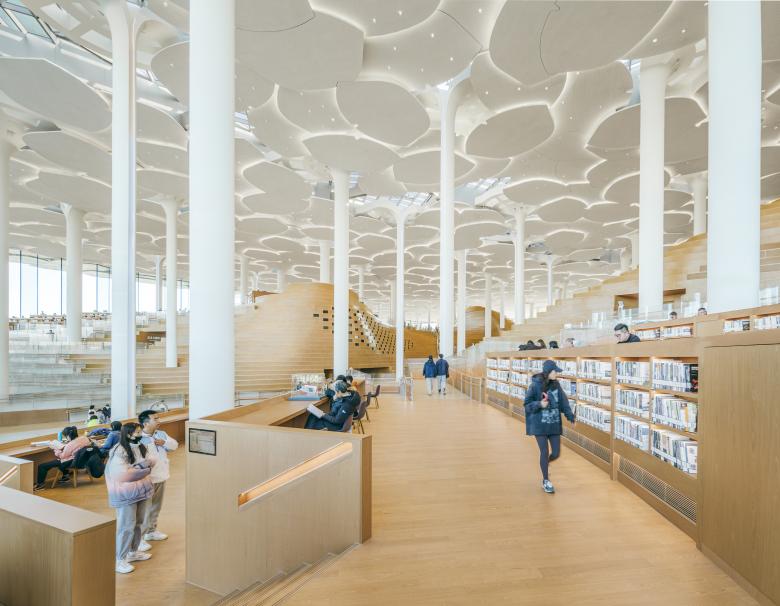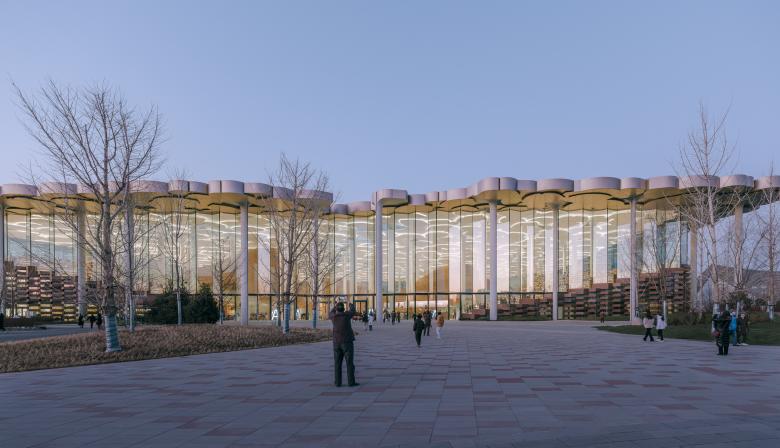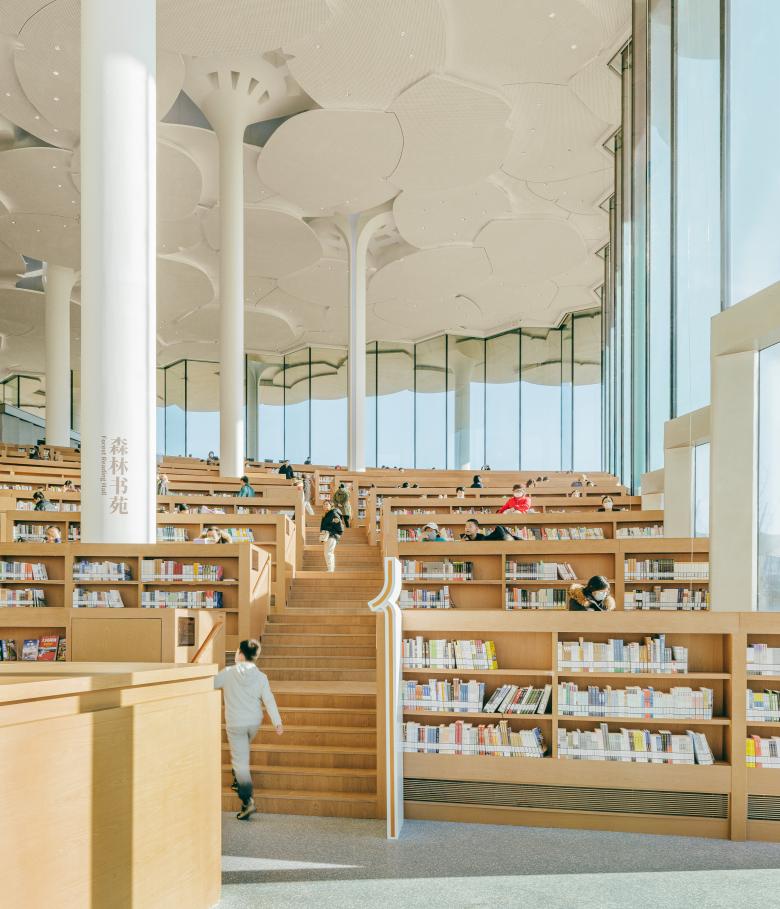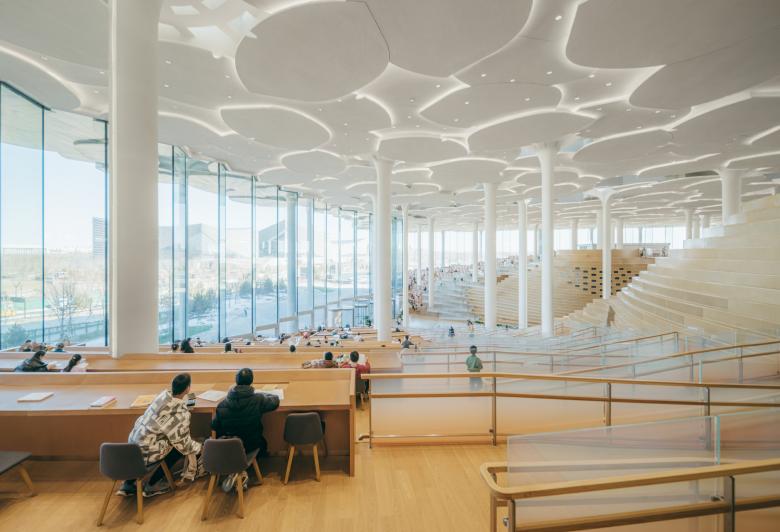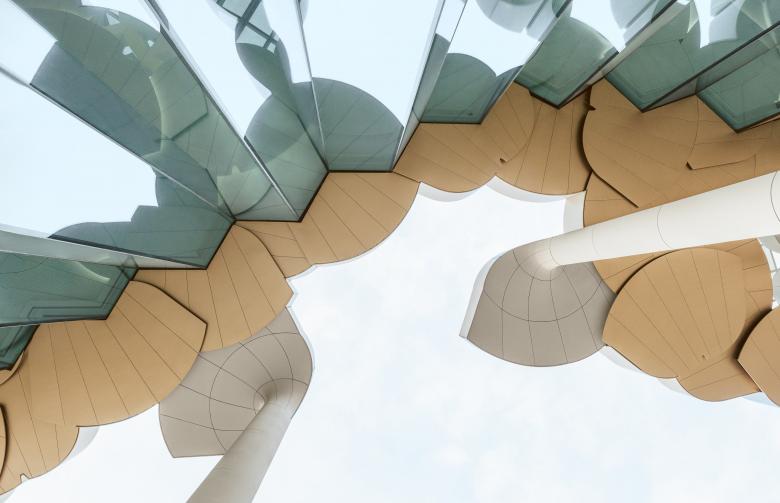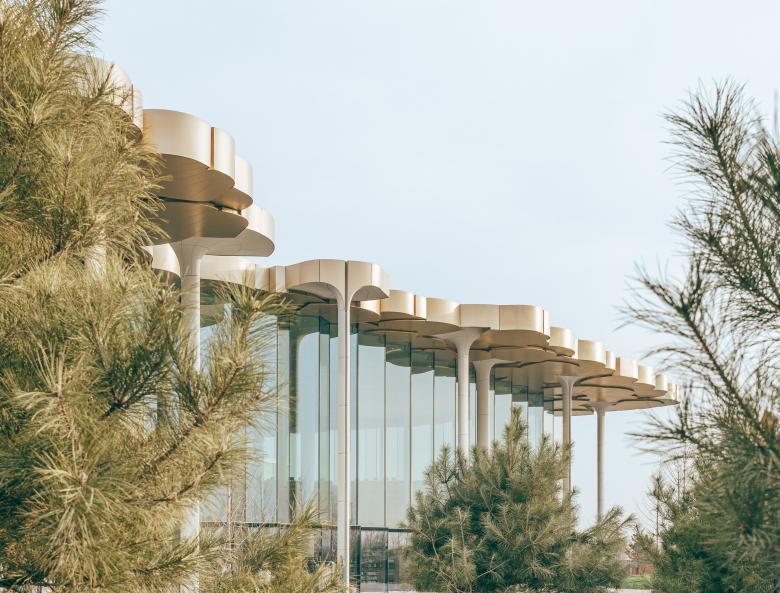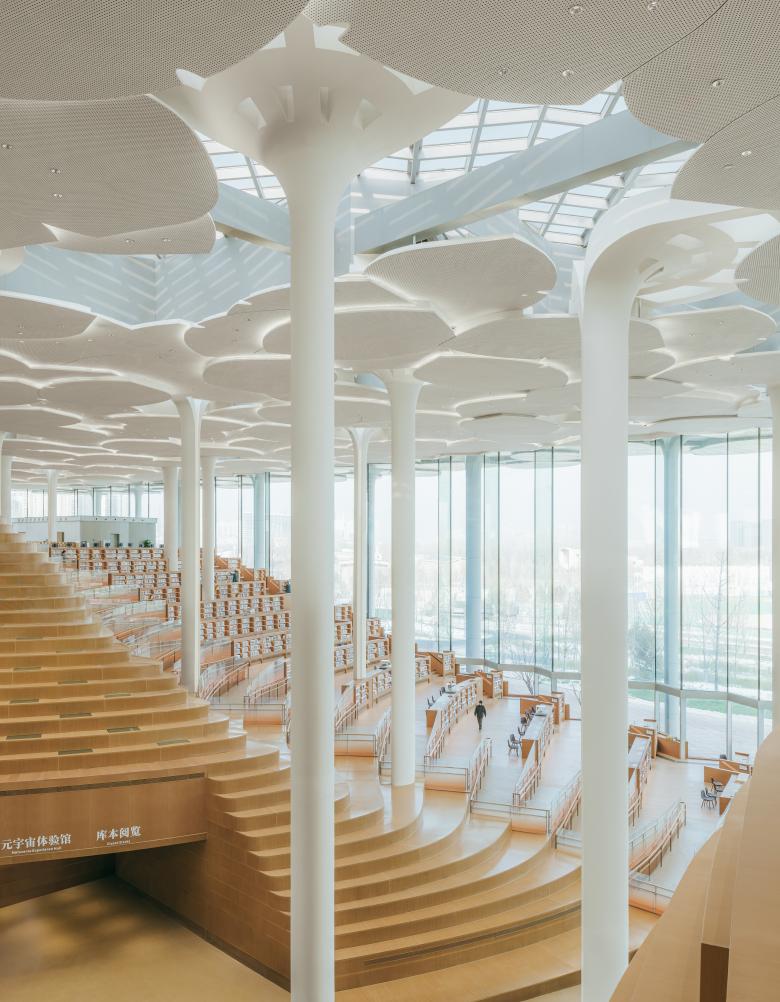Beijing City Library
Tongzhou District, Beijing, 中国
- 建筑师
- Snøhetta
- 位置
- Lv Xin Road Courtyard No.1, Tongzhou District, Beijing, 中国
- 年份
- 2023
- 客户
- Beijing Planning and Natural Resource Bureau
- Executive architect
- ECADI
- Structural, geotechnical, and civil engineer
- ECADI
- Cost Consultant
- ECADI
- Building sustainability engineer
- ECADI
- Façade & BMU engineer
- Eckersley O'Callaghan, Meinhardt
- Lighting designer
- ECADI
- Main Contractor
- China Railway Construction Engineering Group
Snøhetta’s Beijing City Library has opened doors for visitors as the world's largest climatized reading space. It is the firm’s latest innovation in the library typology, thirty-five years after they began work on Bibliotheca Alexandrina in Egypt. The project introduces a contemporary yet indelible place for learning, knowledge-sharing, and socializing to Beijing's rich cultural and intellectual scene.
The new library is located in Tongzhou District, a designated sub-center of Beijing that is often considered the eastern gateway of the capital. As one of three new major cultural buildings in Tongzhou, the Beijing City Library further establishes the area as both a vibrant district in itself and an extension of Beijing's urban fabric. It anchors the neighborhood's ambitious masterplan and will help to catalyze its transformation from a relatively undeveloped area into a lively arts and cultural destination. New transit links to Beijing's center are underway, promising to further integrate Tongzhou with the city and drive visitors to the sub-center.
Snøhetta was awarded the Beijing City Library in 2018 through an international competition and the project was completed with local partner ECADI. The firm is currently working on three libraries in the United States: Charlotte Mecklenburg Library, Far Rockaway Library, and Westchester Square Library.
A decade or so ago, libraries were thought to be a disappearing typology as digitization has increasingly made information accessible at any time and place. To reinstate the library’s relevance in the 21st century, Snøhetta set out to offer a new vision for how it looks, works, and serves the community. The Beijing City Library draws focus on the physicality of a book as an object and the conscious exercise of turning the pages to take in the written word as the primary experience amidst the picturesque setting of hills, trees, and the Tonghui river.
To reestablish the library’s role as an important pillar of public and intellectual life, and become more than a mere repository of books, Snøhetta has positioned the building as a center for learning, culture, and community. Drawing on the historical origins of libraries finding innovative responses to the needs of their time and place, Beijing City Library makes the open exchange of ideas and human dialogue its core purpose. Throughout, there are dedicated spaces for exhibitions, performances, conferences, and the restoration of ancient books. The building firmly rejects the argument of the library becoming a derelict typology with the numerous possibilities it creates, by fostering an emotional connection between books, people, and the natural landscape beyond.
The glass-lined building invites nature into the reading space and lends transparency to the enriched interior environment when viewed from outside. At the heart of the library is a sweeping, nearly 16-meter-tall welcoming forum off of which rise stepped terraces along smooth, rhythmic curves. Carved through the center is a meandering pathway called the Valley, which serves as the main circulation artery of the building. The Valley mirrors the course of the nearby Tonghui river, seamlessly continuing the experience of the landscape beyond and linking the north and south entrances to lead visitors to all other spaces inside.
The terraced hills rising from the Valley are designed to create a sculpted interior landform that serves as the ground, seating, and shelving—an informal zone with opportunities to relax, talk, or read quietly, all while staying connected to the larger space. Semi-private reading areas and conference rooms are embedded into the hills, while book stacks and table seating are set on long, flat areas atop. This central open area is fully accessible and incorporates one of the largest book Automated Storage and Retrieval Systems (ASRS) in the world.
Punctuating the large space to transition between the scale of the Valley and the books are tall, slender columns that mushroom into flat panels shaped like ginkgo leaves—referencing a 290-million-year-old tree species native to China. The overlapping panels and the interstitial glass inserts create a canopy-like roof that floods the interiors with filtered daylight. Under this ginkgo canopy, one can reach the summit that overlooks the valley of books and the horizon of the vast landscape beyond. This experience of oneness with the immediate surroundings and the imagined world offered in books allows the reader to forge memories that are unique to the place.
At the northern and southern edges of the building where real ginkgo trees are planted at the entry points, the hills focus their views outwards to further enhance the connection with nature. The library celebrates Beijing’s natural and cultural heritage by integrating reading, performance, and landscape together.
The Beijing City Library rethinks how libraries today can address the pressing climate challenges while incorporating cutting-edge technology to improve visitor experience. The building achieved China’s GBEL Three Star, the highest attainable sustainability standard in the country, by minimizing both embodied and operational carbon. The project is as much a steward of its environment as of the communities it serves.
The use of modular components and a rationalized structural grid reduces the manufacturing waste for the building. For the ginkgo tree columns, a single module type is rotated on a 9x9m grid throughout the building to give the appearance of variety while being efficient to fabricate and install. These columns also house integrated technology to control interior climate, lighting, and acoustics, as well as collect rainwater from the roof to be reused for irrigation by channeling it to a green infrastructure system.
Generous roof overhangs reduce solar gain on the glass facades—currently the largest load-bearing glass system in China—achieving an important design element without compromising on sustainability. To further optimize the facade, the design reduces the height of the glass on the east and west wells and uses insulated low-E glass. The roof has integrated photovoltaic (BIPV) construction elements that replace the conventional roofing and facade materials, utilizing the prime exposure of the rooftop to sunlight for renewable energy production.
相关项目
杂志
-
Building Bridges with Chris Luebkeman
1 day ago
-
Winners of 2024 EU Mies Awards Announced
2 day ago

